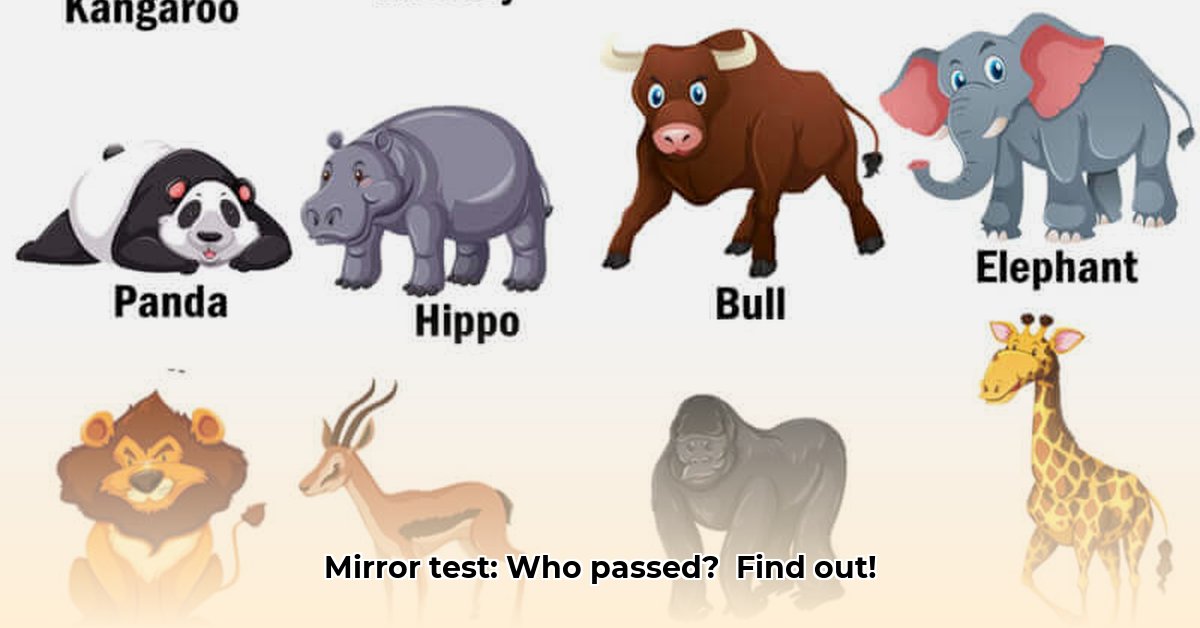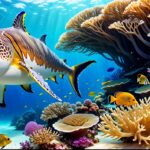Have you ever gazed into your pet’s eyes and wondered if they recognize their own reflection? For decades, scientists have been captivated by this question, employing a fascinating tool called the mirror test to explore the depths of animal cognition. This seemingly simple experiment has yielded surprising discoveries, challenging our understanding of intelligence and self-awareness across the animal kingdom. For more on animal sentience, see this article on scientific evidence.
The Enigmatic Mirror Test: Peeking into Animal Minds
The mirror test, formally known as the mirror self-recognition test (MSR), is designed to assess an animal’s ability to recognize itself as an individual entity, separate from its environment and others. Developed by psychologist Gordon Gallup Jr. in 1970, it presents a unique window into the cognitive abilities of various species.
How the Mirror Test Works: A Glimpse into the Procedure
The procedure involves subtly marking an animal, often with a harmless, odorless dye, on a part of its body it cannot readily see. The animal is then presented with a mirror, and researchers observe its behavior. If the animal touches or investigates the mark on its own body while looking in the mirror, it suggests that it recognizes the reflection as its own image. If the animal reacts to the image as another animal that means they did not pass the test.
Acknowledging the Imperfections of the Mirror Test: Acknowledging its Limitations
While the mirror test has provided invaluable insights, it is essential to acknowledge its limitations. Sensory biases, ecological factors, and individual experiences can significantly influence an animal’s performance. Some species may rely more on senses other than vision, making the test less relevant to their perception of self.
The “Mirror Club”: Which Animals Recognize Themselves?
Despite its limitations, the mirror test has revealed a select group of animals capable of self-recognition. These species, often referred to as the “Mirror Club,” offer a glimpse into the diverse ways self-awareness manifests in the animal kingdom.
The Usual Suspects: Primates and Their Cognitive Prowess
Unsurprisingly, great apes—chimpanzees, bonobos, and orangutans—consistently demonstrate self-recognition in mirror tests. These intelligent primates often use the mirror to inspect themselves, touch the mark, and make faces, indicating an understanding that the reflection is their own. Studies show that chimpanzees, in particular, exhibit self-recognition in about 75% of young adults, a percentage that decreases with age.
Gentle Giants: Elephants and Their Unexpected Self-Awareness
Elephants, renowned for their memory and social complexity, have also surprised scientists by passing the mirror test. In a groundbreaking study, Asian elephants used their trunks to touch visible marks on their heads after observing themselves in a mirror, suggesting a high level of self-awareness likely supported by their large brains and complex social structures. According to Joshua Plotnik, normal elephant behavior can conflict with what the mirror test requires. Plotnik also stated that the mark test assumes that a particular animal will be interested in something weird on their body.
Avian Intelligence: Magpies and Their Cognitive Surprise
Eurasian magpies made history as the first non-mammalian species to pass the mirror test. These birds peck at colored stickers placed on their feathers after viewing their reflection, providing clear evidence of self-recognition. This discovery challenged previous assumptions about the neural structures necessary for self-awareness, as magpies lack the neocortex found in mammals. Franz de Waal, an animal behaviorist, stated that magpies are known for their ability to steal shiny objects and to hide away their loot, so it’s not too far-fetched that a master thief like a magpie has that perspective-taking ability.
Marine Marvels: Dolphins and Their Aquatic Cognition
Bottlenose dolphins have also demonstrated self-recognition abilities, inspecting and attempting to remove marks on their bodies after seeing their reflection. This behavior indicates a sophisticated level of self-recognition and highlights the advanced cognitive capacities found in cetaceans.
Other Members of the Club
- Orcas (Killer Whales): Exhibit behaviors consistent with self-recognition, showing curiosity and investigating marks on their bodies after seeing their reflection.
- False Killer Whales: Demonstrate mirror-directed behaviors suggesting self-recognition, inspecting marks on their bodies when given access to mirrors.
- Cleaner Wrasse Fish: Appeared to pass the mirror test in 2019, attempting to scrape the mark off their bodies after seeing their reflection, igniting scientific debate about the interpretation of the test.
- Ants: In 2015, researchers reported that some ant species responded to marks visible only in a mirror, sparking considerable discussion about self-recognition in invertebrates.
- Manta Rays: Show great interest in their reflections, repeatedly swimming in front of the mirror and displaying unusual behaviors, suggesting they might recognize themselves.
Rethinking Self-Awareness: Beyond the Mirror Test
The mirror test has undoubtedly advanced our understanding of animal cognition, but it is crucial to acknowledge that it is not the only measure of self-awareness. Many animals may possess self-awareness without passing the test due to sensory biases, ecological factors, or social behaviors.
Sensory Ecology: Recognizing the Importance of Smell and Touch
The mirror test primarily focuses on visual recognition, neglecting the significance of other senses, such as smell and touch, in many species. Animals like dogs, who rely heavily on their sense of smell, may not respond to their reflection in the same way as visually oriented species.
Social Complexity: How Gorillas’ Hesitation Impacts Testing
Gorillas, for instance, often fail the mirror test due to their aversion to direct eye contact, a social behavior that may inhibit their exploration of their reflection. This highlights the importance of considering social and ecological factors when interpreting test results.
Alternative Assessments: Exploring New Avenues
Scientists are actively exploring alternative methods to assess self-recognition in animals, including:
- Olfactory Tests: Presenting animals with their own scent and observing their response.
- Tactile Tests: Assessing an animal’s ability to recognize its own body through touch.
- Behavioral Observations: Analyzing spontaneous self-directed behaviors in natural settings.
- Brain Imaging: Investigating the neural correlates of self-recognition in different species.
The Evolutionary Puzzle: Why Did Self-Awareness Evolve?
The fact that self-awareness has evolved independently in diverse animal lineages raises intriguing questions about its adaptive significance. What selective pressures might have driven the evolution of this complex cognitive ability?
Social Intelligence: Navigating Complex Relationships
One hypothesis suggests that self-awareness is linked to social intelligence, allowing animals to better understand themselves and others within complex social structures. Self-awareness may enable animals to predict the behavior of others, engage in cooperation, and compete for resources more effectively.
Environmental Adaptations: Responding to Ecological Demands
Another possibility is that self-awareness is related to environmental adaptations, allowing animals to better navigate their surroundings and solve problems. Self-aware animals may be better equipped to learn new skills, adapt to changing environments, and exploit resources more efficiently.
Convergent Evolution: Independent Paths to a Common Trait
The independent evolution of self-awareness in different species, known as convergent evolution, suggests that this cognitive ability may offer significant advantages in specific ecological and social contexts.
Ethical Considerations: Implications for Animal Welfare
The discovery of self-awareness in animals has profound ethical implications for how we treat them. If animals are capable of recognizing themselves as individuals, experiencing emotions, and understanding their own existence, do they deserve greater moral consideration?
Animal Welfare: Promoting Ethical Treatment
Recognizing self-awareness in animals strengthens the argument for improved animal welfare standards, including:
- Providing enriched environments that meet their physical and psychological needs.
- Reducing stress and promoting positive emotional states.
- Avoiding unnecessary harm and suffering.
Conservation Efforts: Preserving Cognitive Diversity
Understanding the cognitive abilities of different species also highlights the importance of conservation efforts to protect not only biodiversity but also “cognitive diversity.” Preserving the rich tapestry of animal minds ensures that future generations can continue to marvel at the complexities of the natural world.
The Future of Discovery: Exploring Animal Minds
The study of animal self-awareness is an ongoing journey, with many exciting discoveries yet to be made. As scientists continue to refine their methods and explore new avenues of research, we can expect to gain a deeper understanding of the cognitive abilities of animals and their place in the world.
The pursuit of knowledge about animal minds offers a unique opportunity to challenge our assumptions, expand our understanding of the natural world, and promote a more ethical and compassionate relationship with all living creatures.
Summary Table: Animals That Have Passed the Mirror Test
| Species | Result | Notes |
|---|---|---|
| Chimpanzees | Passed | Consistently demonstrate self-recognition, with higher rates among younger adults. |
| Bonobos | Passed | Similar self-recognition abilities to chimpanzees, known for their peaceful and social nature. |
| Orangutans | Passed | Exhibit robust self-recognition in mirror tests, often using mirrors to examine parts of their bodies. |
| Asian Elephants | Passed | Unexpected result, highlighting intelligence and complex social structures. |
| Bottlenose Dolphins | Passed | Demonstrate self-directed behavior in mirrors, inspecting and attempting to remove marks on their bodies. |
| Eurasian Magpies | Passed | A surprising finding, challenging assumptions about the neural structures necessary for self-awareness. |
| Orcas (Killer Whales) | Passed | Exhibit behaviors consistent with self-recognition, showing curiosity and investigating marks on their bodies. |
| False Killer Whales | Passed | Demonstrate mirror-directed behaviors suggesting self-recognition, inspecting marks on their bodies when given access to mirrors. |
| Cleaner Wrasse Fish | Passed | Appeared to pass the mirror test in 2019, attempting to scrape the mark off their bodies, but the interpretation of this result is still debated. |
| Ants | Passed | In 2015, researchers reported that some ant species responded to marks visible only in a mirror, but the interpretation of this result is still debated. |
| Manta Rays | Passed | Manta rays have the largest brains when it comes to fish. They show great interest in their reflections, repeatedly swimming in front of the mirror and displaying unusual behaviors, suggesting they might recognize themselves. |
| Gorillas | Varies | Most gorillas do not pass the mirror test; however, it’s in their nature to avoid eye contact with other gorillas (this is an aggressive gesture in their world). |
How to Improve the Mirror Self-Recognition Test for Non-Primate Animals
Key Takeaways:
- The mirror test provides useful insights; however, it may not accurately measure self-awareness in all species.
- Species-specific sensory biases influence test results. Some animals rely more on smell than sight.
- The test environment can stress animals, affecting their behavior.
- Prior mirror experience significantly impacts performance. This needs to be considered.
- How to improve the mirror self-recognition test for non-primate animals requires a multi-sensory approach and careful consideration of environmental factors.
- Future research should explore alternative methods for assessing self-awareness.
The Mirror Test: A Quick Look
The mirror test assesses self-recognition in animals. A mark is placed on the animal, and researchers observe whether it touches or investigates the mark in the mirror, indicating it recognizes the reflection as itself. But is it really that simple?
Limitations and Controversies
Critics argue that successful performance depends on factors like visual acuity, prior mirror exposure, and the animal’s natural curiosity. Imagine a dog that uses its nose more than its eyes, how would it react? That doesn’t mean it lacks self-awareness.
Refining the Test: A Multi-Sensory Approach
How to improve the mirror self-recognition test for non-primate animals is a central question. We need to move beyond the single-sensory approach and include alternative assessments involving:
- Multi-sensory cues: Incorporate olfactory and auditory cues alongside visual stimuli.
- Naturalistic settings: Conduct tests in environments less stressful for the animals.
- Controlling for prior experience: Carefully record and control the subjects’ previous interactions with mirrors.
- Behavior analysis: Develop detailed behavioral coding systems.
- Comparative studies: Compare results across species with diverse sensory modalities.
Beyond the Mirror
Developing tests that truly assess self-awareness requires innovative methods. These could include analyzing brain activity, observing spontaneous self-directed behaviors in natural settings, and devising alternative tasks stimulating similar cognitive processes.
Essential Cognitive Abilities Beyond the Mirror Test in Diverse Species
Key Takeaways:
- The mirror test, while influential, isn’t the only way to assess self-awareness.
- Many social animals, like chimpanzees and dolphins, pass the mirror test, suggesting a link between social complexity and self-recognition.
- Essential Cognitive Abilities Beyond the Mirror Test in Diverse Species are crucial for a complete understanding of animal consciousness.
- Limitations of the mirror test include sensory biases and potential misinterpretations of animal behavior.
- Future research needs to explore alternative methodologies and incorporate quantitative measures of sociality.
The Mirror Test: A Window into Self-Awareness?
The classic “mirror test” involves marking an animal and observing its reaction to the mark in a mirror. Does it touch the mark, indicating recognition of itself? Some highly intelligent species, like octopuses, may fail due to their reliance on other senses.
Beyond the Looking Glass: Exploring Other Cognitive Abilities
The mirror test, while valuable, provides only a limited view. Many researchers now believe that essential cognitive abilities beyond the mirror test in diverse species offer a richer understanding of self-awareness.
- Theory of Mind: The ability to understand that others have different thoughts, beliefs, and intentions.
- Metacognition: Awareness of one’s own thought processes (thinking about thinking).
- Planning and Problem Solving: These cognitive abilities are also linked to self-awareness.
Sociality and Self-Awareness: A Complex Relationship
A strong correlation exists between social complexity and self-awareness. Highly social species are more likely to pass the mirror test. This suggests a link between social intelligence and self-recognition.
Limitations and Controversies: Interpreting the Evidence
Interpreting the results of the mirror test and other measures of self-awareness is challenging. There’s a risk of anthropomorphism (assigning human characteristics to non-human behavior). Further complicating matters are species-specific sensory differences, social structures, and potential learning biases.
Future Directions in Animal Cognition Research
To fully grasp the spectrum of animal consciousness, we must consider alternative assessment methods. Olfactory tests, for example, might be better suited to species that primarily rely on scent rather than sight. Integrating quantitative measures of social complexity into future studies is crucial.
Ethical Implications of Mirror Test Results for Animal Welfare and Conservation
Key Takeaways:
- The mirror test, while valuable, isn’t a perfect measure of self-awareness.
- Great apes consistently pass; other species, such as dolphins and magpies, show promising results, challenging our assumptions about consciousness.
- The test’s limitations necessitate broader approaches to understanding animal self-awareness.
- Ethical implications of mirror test results are significant for animal welfare and conservation. Recognizing self-awareness in certain animals changes how we view their needs and rights.
The Mirror Test: A Window into Animal Minds?
The famous mirror test has become a cornerstone in studying animal self-awareness. It’s simple: mark an animal inconspicuously, then see if it investigates the mark in a mirror, suggesting it recognizes the reflection as itself.
Some species, like chimpanzees, consistently pass. Others, like gorillas, show inconsistent results, highlighting the test’s limitations. The test might be biased towards visually oriented species. What about animals that rely more on smell or sound?
Beyond the Mirror: A Broader Perspective
Self-awareness is likely far more complex than a single test suggests. We need to consider more than just mirror recognition. Consider social behavior. Highly social species often demonstrate sophisticated understanding of themselves and others. Another crucial element is problem-solving. Clever problem-solvers often show the capacity for metacognition; they understand their own knowledge and limitations.
The Social Intelligence Hypothesis and its Limits
The Social Intelligence Hypothesis (SIH) proposes a link between social complexity and self-awareness. Highly social species might evolve greater self-awareness. The success of magpies strongly supports the need for more research.
Ethical Implications of Mirror Test Results for Animal Welfare and Conservation
The ethical implications of mirror test results are far-reaching. If we acknowledge self-awareness in certain species, it profoundly impacts how we treat them. Their capacity for suffering should be a significant concern. It raises questions about animal experimentation, the ethics of captivity, and conservation efforts.
- The Accidental Breakthrough: Penicillin’s Discovery and Impact - August 1, 2025
- Medieval Universities: Shaping Modern Academia - August 1, 2025
- The Radium Girls: Workplace Safety Lessons from a Tragic Past - August 1, 2025
















